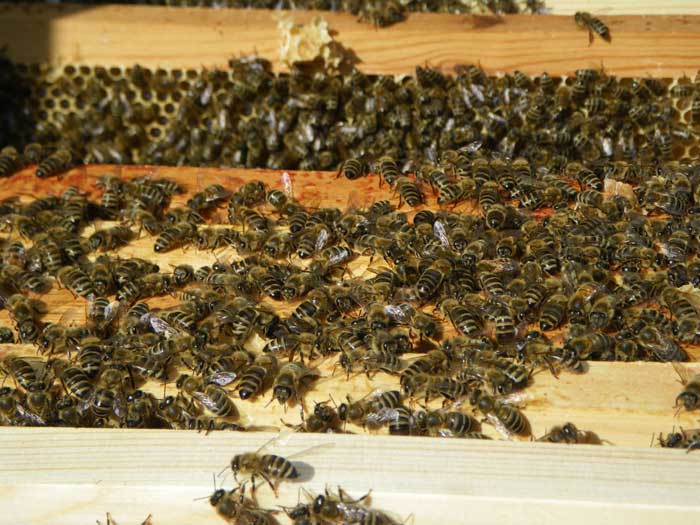Swarming Bees – Followed by a catch
Well, our inexperience with beekeeping has been shown once again. I was hoping for a nice easy inspection today. We inspected last week and reported that all was well in Clettwr but the bees in Leri had swarmed. Today I had hoped to have a quick check in Clettwr to make sure there were no signs of swarming, but to leave Leri alone so that the bees in there could get on with the process of re-queening.
As usual though the bees were having none of it and weren’t about to let me have an easy life. At first Clettwr seemed fine, plenty of bees and they were very docile, but then I came across a frame with queens cells on which are a sure sign that they are about to swarm. Not to worry, we had a plan. As long as the queen was still there, we were going to create a nucleus from the queen cells to hopefully prevent them from swarming.
Creating a nucleus
One of the most commonly used methods to prevent swarming is to create an artificial swarm. This process requires an extra hive which we don’t have and it involves moving the queen complete with many of her attendants, into a new hive and putting this hive back where the original one was. The old hive complete with the colony, the queen cells, but not the queen is then moved to a different location in the apiary. Any flying bees then return to the queen in her new box and the new hive is housed somewhere else in the apiary.
As we don’t have a spare hive we decided to create an nucleus which is very similar as far as I can tell and the end result certainly seems to be the same. The difference is that the queen remains in the original hive whilst a queen cell and many of the bees are moved to a new site in a nuc box. The nucleus needs to be quite strong in order to raise a queen from a queen cell so this reduces the population considerably in the original hive. It is hoped that the reduction in population will prevent the original colony from swarming and that the bees in the nuc box can rear a new queen and create a new colony.
So, I found the queen, at least she was still there, move a frame with a decent queen cell into the nuc box, complete with its bees, I then moved a couple of other frames with brood, larvae and stores into the nuc box and shook a couple of frames worth of bees into it. Put the lid on, and placed the nuc box across the other end of the garden, about 10m away from the original hive with the entrance facing at right angles to that of the original hive. I also plugged the entrance with grass to stop the bees flying straight back to the original colony.
I then replaced the frames I’d removed from the hive with new empty frames and put the hive back together. In hindsight I may not have shaken enough bees into the nuc box, but I had to do something and with no one there to help I had to make some decisions on the fly (with very little knowledge of what I was doing!)
I stood back to look at the hives and think about what I’d done when I noticed thousands of bees streaming out of Leri, our other hive. I had hoped to leave this hive alone today but the bees were up to something – It looked as though they were swarming!!
Swarm!
It was quite impressive to watch, I thought that this colony was fairly small as they had already swarmed once so was surprised to see quite so many bees leaving the hive. Once again it was less than a week since we’d checked them so I have no idea why they are swarming so much and so quickly, but swarming they were.
I watched them flying around the garden and was ready to follow them in my bee-suit to wherever they might congregate. Thankfully they landed on the raspberries in our garden so after letting them settle I was able to catch them.
Catching the Swarm
I had a plastic nuc box ready for just such an occurrence, complete with five frames of foundation. I got this out, along with my secateurs and started to gently cut the stems on which they had clustered and shake the bees into the box. It was difficult to get them as one big cluster but I got as many of them as I could and then left the box just above the remaining bees and over the next 10-20 minutes watched them all crawl into the box.
I had caught the swarm! Once they were all in the box I put the lid on, sealed the entrance and put them at the bottom of the garden which is where they will stay untilIi’ve had chance to talk to someone else to find out what I should do next!
Meanwhile, the bees in the other nuc box had already managed to get out through my plug of grass – That didn’t work then. No doubt that isn’t the only thing I’ve done wrong but this morning we had two colonies of honey bees, one that I thought was happy and healthy another that I was hoping was re-queening itself. All of a sudden though we have two hives, one that is still presumably in the process of re-queening and another with a queen that has been thinking about swarming. We also have two nuc boxes, one with a queen cell that may, all being wel,l re-queen itself. Another with a swarm in it – who knows if that swarm has a queen with it and what it will do next?
Our next task is to get hold of someone who knows more than we do, tell them what we’ve done (let them ridicule is for that) and then see what needs to be done next. These bees are certainly giving us the run around!



















So, swarming is a bad thing then? Does it mean the queen has left the hive or something equally rubbish?
Please excuse my bee-related ignorance!
Yep, a swarm is usually the queen leaving the hive, along with half of the colony. They are off to pastures new to set up a new colony. It is their way of reproducing, so it’s not really a bad thing as far as the bees are concerned, but it is for the beekeeper as he/she is loosing half his/her bees and probably the chance of any honey for that year with it.
As far as we know though this is the second swarm to leave this colony and it looks as though our other hive is about to follow suit as well – I wouldn’t hold out hope for too much Ynyslas honey this year!
I only hope we have some bees left by the end of the summer so that they can make it through the winter – We paid out over £300 for our bees this year, we don’t want to just see them all fly away!
Al.
Right, it all makes sense now. I’m reading your bee-keeping updates with interest as, once our house is sorted, I’m looking for interesting projects to get me out from under the wife’s feet!
It’s certainly interesting and if our exploits are anything to go by they’ll keep you busy! It is pretty cool having bees at the bottom of the garden though and if we get any honey from them then it’ll be a bonus!
There’s more to it than you might think though.
Al.
After a chat with some more experienced beekeepers than us, we were reassured to hear that we had done the right thing with the first hive and that our artificial swarm procedure was the correct one to take in the circumstances.
It was also decided that the swarm from the second colony may well have returned to the hive on its own accord, but may have been equally as likely to disappear off over the horizon. Catching the swarm was therefore the right thing to do, but we have now put the bees from this swarm back into the hive from whence it came. Lets hope they stay there this time!
As is becoming customary for us, we re-united the swarm with its original colony under the cover of darkness (almost) last night.
Al.